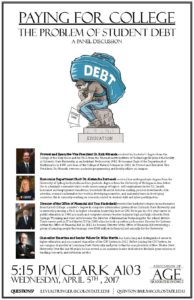Story by Levi Altringer and Quinton Bara
The Association of Graduate Economics at CSU is hosting a panel discussion on April 5 titled, “Paying for College: The Problem of Student Debt.”
The panel will feature four members of the CSU community – Provost Rick Miranda, Director of Financial Aid Tom Biedscheid, Chancellor Emeritus and Senior Fellow Mike Martin and Department of Economics Chair Alex Bernasek. Each panelist will give a short presentation, followed by question and answer session. The event will take place at 5:15 p.m. in Clark A103, and is free and open to the public.
 The problem of student debt has received attention as being one of America’s most pressing economic issues. A 2015 study published by The Institute for College Access and Success reported that 68 percent of college seniors owed an average of $30,100 upon graduating from a public or private nonprofit institution, an increase of 4 percent above the 2014 average of $28,950. Total student borrowing (federal and nonfederal) has increased markedly over the last 20 years. In 1996, students borrowed a total of $42.6 billion, while students in 2016 borrowed a total of $106.8 billion, a 250 percent increase in borrowing. Accumulated student debt now stands at $1.3 trillion.
The problem of student debt has received attention as being one of America’s most pressing economic issues. A 2015 study published by The Institute for College Access and Success reported that 68 percent of college seniors owed an average of $30,100 upon graduating from a public or private nonprofit institution, an increase of 4 percent above the 2014 average of $28,950. Total student borrowing (federal and nonfederal) has increased markedly over the last 20 years. In 1996, students borrowed a total of $42.6 billion, while students in 2016 borrowed a total of $106.8 billion, a 250 percent increase in borrowing. Accumulated student debt now stands at $1.3 trillion.
Multiple causes, effects
The student debt problem has multiple causes. State spending on higher education has failed to keep up with inflation and growth in college enrollment. In addition, state spending on education has diminished at all levels due to the direction of state funds to other programs like Medicaid.
In 1987, spending on higher education made up 12 percent of state budgets and Medicaid about 10 percent. By 2011, higher education accounted for just 10 percent and Medicaid almost a quarter. Not only have states “disinvested,” but institutional expenditure continues to increase from year to year. All of this means that a larger portion of the cost of college falls on students and their families. Both sticker price and net tuition have increased steadily over the last two decades, in real terms. Stagnant middle incomes have only exacerbated the problem, causing an increasing number of students and families to borrow an increasing amount of money to fund their, or their child’s, education.
Just as the student debt problem has multiple causes, it also has multiple effects. First, debt deters students from pursuing a degree, especially those coming from families at the lower end of the income spectrum. Unfortunately, this affects accessibility for already underrepresented minorities in higher education. Second, as loans take the place of grants and an affordable education, the line between “earning” a degree and “buying” a degree becomes blurred – the commoditization of higher education. This poses a serious question to the purpose of higher education.
Lastly, student debt can impact labor market decisions. A student’s choice of major may be increasingly driven by pecuniary gain as average student debt rises, and a student with a considerable amount of student loans, once graduated, may choose employment entirely on the basis of income needed for the repayment of those loans, creating productive inefficiency.
There are no doubt dozens of causes and the effects are uncountable, as each student’s debt poses a unique challenge to that individual. However, the complexity of the problem is why it must be discussed.
Economics majors Altringer and Bara can be reached at Levi.Altringer@colostate.edu and Quinton.Bara@colostate.edu.